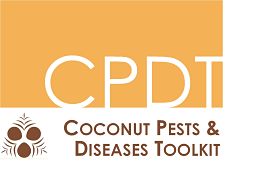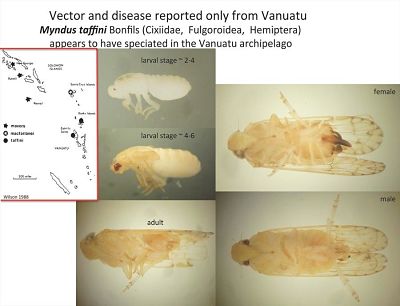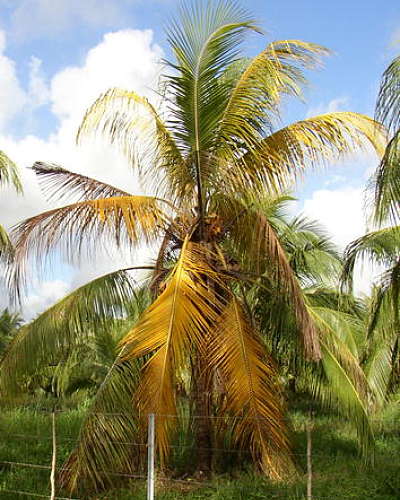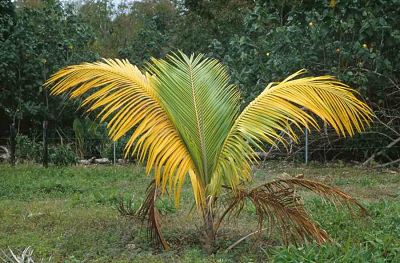Coconut foliar decay
Coconut foliar decay is a lethal disease of coconuts found in Vanuatu. It is considered a HIGH risk disease in the Pacific.
Common name of the diseaseCoconut foliar decay |
Scientific name of the cause of the diseaseCoconut foliar decay virus (CFDV) |
on this page: Vector insects : Symptoms : Impacts : Distribution : Prevention : Controlling coconut foliar decay : Information sources and further reading
Coconut foliar decay is caused by a very small virus that is in the phloem (where food is transported through the plant) of coconuts at low concentrations. The virus can be found in the roots, trunk, leaves and the nut including the husk and embryo, but it is unknown whether seeds carry it.
As the virus cannot be seen, the only way to identify coconut foliar decay is by symptoms and the presence of vector insects.
Vector insects
Insects that can spread diseases like viruses are called vectors. The virus must be able to reproduce inside a vector insect’s body, and then move out through its mouth parts when it feeds on a new host plant. Usually this is only possible in a small number of insect species.
|
The only known insect that transmits coconut foliar decay is a planthopper called Myndus taffini. Sometimes the disease has been called foliar decay Myndus taffini. Although the adult planthopper feeds on coconuts, breeding occurs on the roots of Hibiscus tiliaceous (hau [Hawai'ian], fau [Samoan], purau [Tahitian], and vau tree). However, Hibiscus tiliaceous and other plants growing near coconuts do not carry the virus. It is not known if Myndus taffini is infected by the virus in nymph, adult or both life stages or whether the virus reproduces in the planthopper. |
Life stages of the vector insect, Myndus taffini (© PestNet) |
SymptomsWhen Hibiscus tiliaceous are planted as fences around sections of coconut palms, the breeding sites of Myndus taffini are in close proximity and symptoms may start to appear on the palms that are closest to this fence. The first sign of infection is in the mid-section of the crown where fronds have a few yellowing leaflets. Yellowing will begin to spread and the whole frond will bend and be seen hanging through leaves that are still green due to breakage near the base of the frond. As younger leaves age, they too will go through these stages. At the advanced stage of the disease, look for a yellowed, broken leaf mid-section hanging through green fronds and new green fronds emerging from the top of the crown. The trunk may also show a narrowing near the crown. If palms are not tolerant to the disease, death will occur in infected palms after 1-2 years. The Malayan Red Dwarf variety of coconut is highly susceptible to the disease, showing symptoms 7-10 months after infection. |
Yellowed and broken mid-section with new green fronds emerging from the top of the crown (© Jean-Pierre Labouisse, CIRAD) |
ImpactsVanuatu's native coconut varieties, Vanuatu Tall or Vanuatu Dwarf, are suggested to be resistant to the lethal virus as they do not show symptoms. However, most introduced varieties are affected and only a few are tolerant (can recover) such as the Renell Tall variety. The Malayan Red Dwarf is not so lucky and is highly susceptible to infection. This is a problem in Vanuatu as introduced varieties deliver higher yields than local varieties. If it is not possible to grow hybrid palms that are resistant or tolerant to the virus, major reductions in yields of around 42-66% can be expected. |
Susceptible Malayan dwarf seedling showing foliar decay (© John Randles, Waite Agricultural Research Institute) |
The current value per kg of copra produced is around US$ 0.40. Therefore, if introduced varieties that produce a high yield of 24-38 kg copra per tree become infected, the losses would be substantial.
These impacts seriously threaten the economy of Vanuatu, as coconut products are a major source of income for the country and support the livelihood of the people.
For an up-to-date list of hybrid palms in Vanuatu, visit the Replant Coconut website.
Distribution
Please check with your local biosecurity / quarantine or SPC for up-to-date distribution information.
Coconut foliar decay is only recorded from Vanuatu.
Prevention
Most importantly, the International Guidelines for transfer of coconut germplasm should be strictly followed to prevent pests and diseases being moved to new locations.
Unrestricted transport of coconut tissues is likely to avoid testing for insects and diseases and can lead to introduction of coconut foliar decay into unaffected areas.
There are no simple methods for detecting the virus generally available. However, research is ongoing and molecular detection methods might become available in the near future. Detection of the virus in sap may be missed due to the difficulty in viewing with electron microscopy, and lack of access to this technology in the Pacific. Please contact SPC for further information.
For general information on preventing pests and diseases of coconut, see the Prevention section.
Controlling coconut foliar decay
When possible The FAO/IBPGR Technical Guidelines for the Safe Movement of Coconut Germplasm should be followed. The embryos of coconut should be grown in a sterile culture medium when transported.
Removal or treatment of the Hibiscus tiliaceous fences where Myndus taffini breed could be a possible solution to reduce the spread of the virus. Large-scale commercial plantations that tend to plant the susceptible introduced or hybrid palms would benefit from removal of these fences. However, removal or treatment of Hibiscus tiliaceous for small holder farms would not be economical as they plant the resistant local variety Vanuatu Tall. Therefore, there may be resistance from growers to removal of fences as a mthod of control.
Spraying of fences and palms with pesticides to kill the insects is also not a recommended solution due to the high costs of the chemicals and the skill needed to reach heights of palms.
Planting Vanuatu Tall or Vanuatu Tall x Vanuatu Red Dwarf hybrid is recommended as the best approach to reduce the spread of disease and ensure a stable harvest of coconut products.
Information sources and further reading
Gronenborn et al. 2018. Analysis of DNAs associated with coconut foliar decay disease implicates a unique single-stranded DNA virus representing a new taxon. Scientific Reports 8: 5698. [ONLINE]
Labouisse, Sileye, Bonnot, Baudouin. 2011. Achievements in breeding coconut hybrids for tolerance to coconut foliar decay disease in Vanuatu, South Pacific. Euphytica, 177(1), pp.1-13. Request required.
PestNet. 2017. Coconut foliar decay. [ONLINE]
Plantwise. 2018. New Hebrides coconut disease (Coconut foliar decay virus). [ONLINE]
Plant Village. 2018. Coconut; Diseases and Pests, Description, Uses, Propagation. [ONLINE]
content reviewed by Richard Davis, Northern Australia Quarantine Strategy, Department of Agriculture and Water Resources, July 2018



